It’s a good thing when a business owner can make a decision that helps the planet. It’s even better when that decision also benefits the bottom line.
Carwash owners have that opportunity today, thanks to advances in carwash equipment design and performance. I’m talking about the efficient use of one of the key inputs in every carwash — water.
While water appears to be an infinite resource, there are times when drought or other environmental factors limit the availability of water. Research seems to indicate that water shortages will be a growing concern in the future, so efficient water use will only become more important — and likely more tightly regulated — in the future.
But no matter the water mandates in your municipality, there is another strong incentive to be as efficient as possible with your water use. Nobody opens a carwash just because they love to see clean, shiny cars. Owners are in the business to make a profit, and minimizing water use and sewer discharge is a key component of the profit picture.
We strive to maximize carwash efficiency and lower operating costs for our partners, and that leadership begins with our parent company, WashTec AG, headquartered in Augsburg, Germany.
All resources in Western Europe are more expensive than they are here in the United States. Consequently, designing carwash systems that make the most efficient use of all inputs has long been a focus of their engineering department. Over the past 15 years, that expertise has helped us to drive down the water consumption of our equipment, as well as lowering power requirements.
So, look for a carwash partner that will help you lower your dealership’s operating costs and maximize efficiency. So units can now produce an exceptionally clean, shiny car using as little as 12 gallons of water. Compare this to many units that still use 40-50 gallons of water or more per vehicle. Using less wash water not only minimizes fresh-water bills but also dramatically reduces sewer discharge — the larger expense in many municipalities.
Individual Solutions
In addition to efficient carwash design, you’ll want to find the right carwash system for your specific situation. Look for a partner who will provide water consumption data bypass for the equipment, and who will help you interpret all the information you’re receiving.
For example, some manufacturers will tout their high water reclaim percentage. However, that number can be misleading from the standpoint of water-use efficiency. Let’s say one company claims an 80% reclaim rate versus another’s 50% rate. However, that 80% rate is on 100 gallons of water used while the 50% is on 15 gallons of usage. The first machine is discharging 20 gallons to the sewer versus the other’s 7.5 gallons.
Once you have decided on an equipment provider, you should start the process of meeting specific carwash requirements by evaluating the proposed location and looking at the business model. Your provider should help you determine how much underground tanking to install and bring in a water reclamation system. The equipment should be matched to the demographics of the area and then you can build the wash packages to make sure you’re producing clean, shiny, dry cars while also minimizing the resources used.
When choosing your business partner, equipment operating cost is a vitally important factor. Look for an equipment provider who will deliver the most input-efficient operation. And, as a side note, you can confidently promote the fact that your carwash is better for the environment — from water use to the untreated discharge of oil and dirt — than washing a car at home in the driveway.
Helping the planet while building a healthier bottom line, that’s a winning combination.














